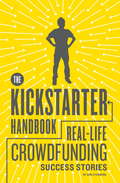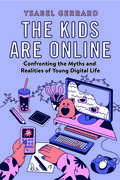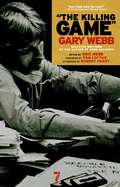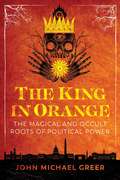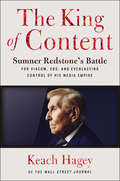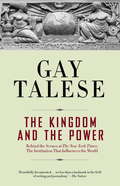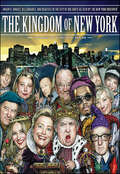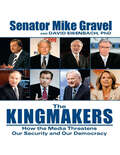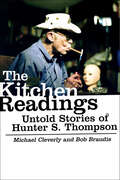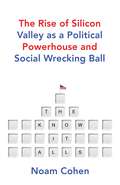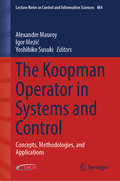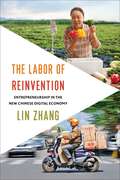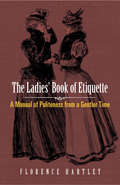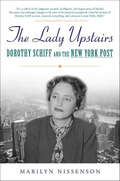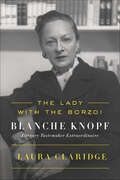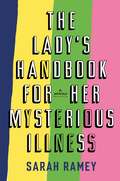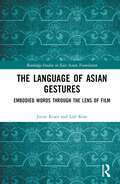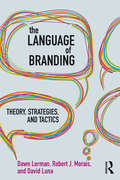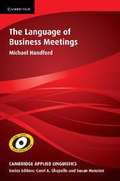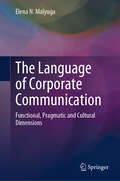- Table View
- List View
The Kickstarter Handbook
by Don SteinbergA business book for 21st-century entrepreneurs, THE KICKSTARTER HANDBOOK will be the first book to market on a phenomenally popular website--and a new way of financing your wildest dreams.
The Kickstarter Handbook: Real-Life Crowdfunding Success Stories
by Don SteinbergSo you want to produce a short film. Or design a new line of jewelry. Or manufacture a revolutionary solar-powered garden sprinkler. There's just one catch: You need $100,000 to bankroll your dream, and your checking account has barely enough to cover the rent. Enter Kickstarter.com--the phenomenal "crowdfunding" website launched in 2009 that brings venture capital to the masses. At Kickstarter, it's not uncommon for entrepreneurs to raise $50,000, $100,000, $250,000, or more. All you need is a great idea--and The Kickstarter Handbook. Business journliast Don Steinberg has interviewed dozens of artists and inventors who launched their passion projects online. Through their voices, you'll explore all the strategies of a successful Kickstarter campaign. You'll learn the elements of a compelling Kickstarter video, innovative ways to market your projects, tips for getting donors onboard, and the secrets of irresistible Kickstarter "rewards." You'll also discover what to do in a best-case scenario--when your project goes viral and the cash starts flowing in. On Kickstarter, it happens to a few lucky visionaries every week. Here's how to be one of them.
The Kid: What Happened After My Boyfriend and I Decided to Go Get Pregnant
by Dan SavageDan Savage's nationally syndicated sex advice column, "Savage Love," enrages and excites more than four million people each week. In The Kid, Savage tells a no-holds-barred, high-energy story of an ordinary American couple who wants to have a baby. Except that in this case the couple happens to be Dan and his boyfriend. That fact, in the face of a society enormously uneasy with gay adoption, makes for an edgy, entertaining, and illuminating read. When Dan and his boyfriend are finally presented with an infant badly in need of parenting, they find themselves caught up in a drama that extends well beyond the confines of their immediate world. A story about confronting homophobia, falling in love, getting older, and getting a little bit smarter, The Kid is a book about the very human desire to have a family.
The Kids Are Online: Confronting the Myths and Realities of Young Digital Life
by Ysabel GerrardA nuanced, intimate picture of how young people live with and on social media. Today's young people find themselves at the center of widespread debates about their online safety, and they are often told that social media platforms affect their mental health and body image by exposing them to cyberbullying and distressing images. Foregrounding their voices and experiences, The Kids Are Online explores how they navigate their identities across platforms and how they really feel about their young digital lives. Ysabel Gerrard talked to more than a hundred teens to unpack the myths and realities of their social media use. Instead of framing today's big platforms as either good or bad, she identifies moments when young people encounter social apps in paradoxical ways—both good and bad at the same time. Using the concepts of stigma, secrecy, safety, and social comparison, she helps readers understand young people's experiences. The Kids Are Online proposes a series of recommendations for parents, families, schools, technology companies, and policymakers to imagine how we might build safer social media systems.
The Killing Game
by Gary WebbGary Webb had an inborn journalistic tendency to track down corruption and expose it. For over thirty-four years, he wrote stories about corruption from county, state, and federal levels. He had an almost magnetic effect to these kinds of stories, and it was almost as if the stories found him. It was his gift, and, ultimately, it was his downfall.He was best known for his story Dark Alliance, written for the San Jose Mercury News in 1996. In it Webb linked the CIA to the crack-cocaine epidemic in Los Angeles during the Iran Contra scandal. His only published book, Dark Alliance is still a classic of contemporary journalism. But his life consisted of much more than this one story, and The Killing Game is a collection of his best investigative stories from his beginning at the Kentucky Post to his end at the Sacramento News & Review. It includes Webb's series at the Kentucky Post on organized crime in the coal industry, at the Cleveland Plain Dealer on Ohio State's negligent medical board, and on the US military's funding of first-person shooter video games. The Killing Game is a dedication to his life's work outside of Dark Alliance, and it's an exhibition of investigative journalism in its truest form.
The Kindness Club on Mapleberry Lane
by Helen Rolfe'A warm, comforting tale of family and community which brims with kindness and love' Annie Lyons'A heartwarming story about family, forgiveness and the importance of kindness... If you're looking for a feelgood novel in these difficult times, this is definitely it!' Fiona HarperThe smallest things can make the biggest difference...Veronica Beecham's cottage is the neatest house on Mapleberry Lane. A place for everything, and everything in its place - that's her motto. But within her wisteria-covered walls, Veronica has a secret: she's hardly left her perfect home in years.Then her teenage granddaughter, Audrey, arrives on the doorstep, and Veronica's orderly life is turned upside down. Shy and lonely, Audrey is struggling to find her place in the world. As a bond begins to form between the two women, Audrey develops a plan to give her gran the courage to reconnect with the community - they'll form a kindness club, with one generous action a day to help someone in the village, and perhaps help each other at the same time. As their small acts of kindness begins to ripple outwards, both Veronica and Audrey find that with each passing day, they feel a little braver. There's just one task left before the end of the year: to make Veronica's own secret wish come true...A heartwarming story with community at its heart, about the little kindnesses that make the world a better place. Perfect for fans of Cathy Bramley and Holly Hepburn!***Readers adore Helen's heartwarming storytelling'Enchanting... Employing all the warmth and charm of Maeve Binchy, and a special brand of kindness that she has made her own, Rolfe weaves together elements of mystery, romance, family relationships and the warmth of community in a story guaranteed to bring laughter, tears and miles of smiles' Lancashire Post'A lovely community, full of friendship and love''I enjoyed every minute of this book and found it very hard to put down''Lovely, feel-good...filled with lots of love''Gave you all the emotions: suspense, happiness and excitement''Helen Rolfe's writing brought a smile to my face''Loved loved loved this fabulous book''Full of wonderful characters, great food, a lovely location'
The Kindness of Strangers
by Kate AdieKate Adie's story is an unusual one. Raised in post-war Sunderland, where life was 'a sunny experience, full of meat-paste sandwiches and Sunday school', she has reported memorably and courageously from many of the world's trouble spots since she joined the BBC in 1969. THE KINDNESS OF STRANGERS encompasses Adie's reporting from, inter alia, Northern Ireland, the Middle East, Tiananmen Square and, of course, the Gulf War of 1991. It offers a compelling combination of vivid frontline reporting and evocative writing and reveals the extraordinarily demanding life of the woman who is always at the heart of the action. Although an intensely private person, Kate Adie also divulges what it's like to be a woman in a man's world - an inspiration to many working women.
The Kindness of Strangers: The Autobiography
by Kate AdieKate Adie's story is an unusual one. Raised in post-war Sunderland, where life was 'a sunny experience, full of meat-paste sandwiches and Sunday school', she has reported memorably and courageously from many of the world's trouble spots since she joined the BBC in 1969. THE KINDNESS OF STRANGERS encompasses Adie's reporting from, inter alia, Northern Ireland, the Middle East, Tiananmen Square and, of course, the Gulf War of 1991. It offers a compelling combination of vivid frontline reporting and evocative writing and reveals the extraordinarily demanding life of the woman who is always at the heart of the action. Although an intensely private person, Kate Adie also divulges what it's like to be a woman in a man's world - an inspiration to many working women.
The King in Orange: The Magical and Occult Roots of Political Power
by John Michael Greer• Details the magical war that took place behind the scenes of the 2016 election • Examines in detail the failed magical actions of Trump&’s opponents, with insights on political magic from Dion Fortune&’s war letters • Reveals the influence of a number of occult forces from Julius Evola to chaos magick to show how the political and magical landscape of American society has permanently changed since the 2016 election Magic and politics seem like unlikely bedfellows, but in e King in Orange, author John Michael Greer goes beyond super cial memes and extreme partisanship to reveal the unmentionable realities that spawned the unexpected presidential victory of an elderly real-estate mogul turned reality-TV star and which continue to drive the deepening divide that is now the de ning characteristic of American society. Greer convincingly shows how two competing schools of magic were led to contend for the presidency in 2016 and details the magical war that took place behind the scenes of the campaign. rough the in uence of a number of occult forces, from Julius Evola to chaos magicians as well as the cult of positive thinking, Greer shows that the main contenders in this magical war were the status quo magical state--as de ned by the late scholar Ioan Couliano--which has repurposed the &“manipulative magic&” techniques of the Renaissance magi into the subliminal techniques of modern advertising, and an older, deeper, and less reasonable form of magic--the &“magic of the excluded&”--which was employed by chaos magicians and alt-right internet wizards, whose desires coalesced in the form of a frog avatar that led the assault against the world we knew. Examining in detail the magical actions of Trump&’s opponents, with insights on political magic from occultist Dion Fortune&’s war letters, the author discusses how the magic of the privileged has functioned to keep the comfortable classes from being able to respond e ectively to the populist challenge and how and why the &“Magic Resistance,&” which tried to turn magic against Trump, has failed. Showing how the political and magical landscape of American society has permanently changed since the 2016 election cycle, Greer reveals that understanding the coming of the King in Orange will be a crucial step in making sense of the world for a long time to come.
The King of Content: Sumner Redstone's Battle for Viacom, CBS, and Everlasting Control of His Media Empire
by Keach Hagey“An epic story . . . filled with legal conflicts, boardroom battles, angry ex-girlfriends, family drama and a ninety-five-year-old media mogul.” —The Washington PostSumner Murray Redstone, who lived by the credo “content is king,” leveraged his father’s chain of drive-in movie theaters into one of the world’s greatest media empires through a series of audacious takeovers designed to ensure his permanent control. Over the course of this meteoric rise, he made his share of enemies and feuded with nearly every member of his family.In The King of Content, Wall Street Journal reporter Keach Hagey deconstructs Redstone’s rise from Boston’s West End through Harvard Law School to the highest echelons of American business. The mogul’s life became a tabloid soap opera, the center of acrimonious legal battles throughout his vast holdings, which included Paramount Pictures and two of the largest public media companies, Viacom and CBS. At the heart of these lawsuits was Redstone’s tumultuous love life and complicated relationship with his children. Redstone’s daughter, Shari, has emerged as his de facto successor, but only after she ousted his closest confidant in a fierce power struggle.Yet Redstone’s assets face an existential threat that goes beyond his family, disgruntled ex-girlfriends, or even the management of his companies: the changing nature of media consumption. As more people cut their cable cords, CBS, with its focus on sports and broadcast TV, has held steady, while Viacom, with its once-great cable channels like MTV and Nickelodeon, has suffered a precipitous fall. As their rivals merge, the question is whether Shari’s push to undo her father’s last big strategic maneuver and recombine CBS and Viacom will be enough to shore up their future.A biography and corporate whodunit filled with surprising details, The King of Content investigates Redstone’s impact on business and popular culture, as well as the family feuds, corporate battles, and questionable alliances that go back decades—all laid bare in this authoritative book.
The Kingdom and the Power
by Gay TaleseThe classic inside story of The New York Times, the most prestigious, and perhaps the most powerful, of all American newspapers. Bestselling author Talese lays bare the secret internal intrigues behind the tradition of front page exposes in a story as gripping as a work of fiction and as immediate as today's headlines.From the Trade Paperback edition.
The Kingdom of New York: Knights, Knaves, Billionaires, and Beauties in the City of Big Shots
by New York ObserverThe Kingdom of New York is rollicking insider;s history of contemporary New York, as seen through the lens of the city’s most irreverent newspaper, the New York Observer. Handsomely designed with great drawings, cartoons, and other illustrations throughout and filled with the paper’s unique attention to politics, status, and wealth, this unique insider’s view features essays by Cynthia Ozick, Gay Talese, Woody Allen, and Martin Scorsese, and covers such iconic New York personalities as Bill and Hillary Clinton, Rudy Giuliani, Michael Bloomberg, Graydon Carter, Katie Couric, Tom Wolfe, Norman Mailer, Tina Fey, J. Lo, Seinfeld, Tina Brown, and Anderson Cooper.
The Kingmakers: How the Media Threatens Our Security and Our Democracy
by Mike Gravel David EisenbachWhy does the media always blow the big stories? From 9/11 and Iraq's Weapons of Mass Destruction to Iran's nuclear program and presidential elections, the divide between reality and the so-called "news" has never been more dramatic or dangerous. In The Kingmakers, Senator Mike Gravel and Dr. David Eisenbach argue that the media's failure to present the public with an accurate view of the world poses a greater threat to American lives than terrorism. They also show how the greatest threat to our democracy is not money— it's the media. Long before the majority of voters pay attention to elections, the media Kingmakers filter the presidential field and anoint the "leading candidates." Gravel and Eisenbach propose a powerful antidote to the Kingmakers' poisonous influence on American politics: participatory journalism. Blogs, chat rooms, virtual worlds, and internet contributions have empowered ordinary citizens to change the course of American and world history.
The Kitchen Readings: Untold Stories of Hunter S. Thompson
by Michael Cleverly Bob BraudisWarning!* This book contains the following:Unsafe use of powerful firearms in combination with explosivesCultivation of illegal crops Impressionable minors being exposed to illicit activitiesPiloting of automobiles under impaired conditionsTransporting large sums of cash across national borders*Stunts performed in this book were undertaken by professionals. Do not attempt them at home.
The Know-It-Alls: The Rise of Silicon Valley as a Political Powerhouse and Social Wrecking Ball
by Noam CohenThe world&’s tech giants are at the centre of controversies over fake news, free speech and hate speech on platforms where influence is bought and sold. Yet, at the outset, almost everyone thought the internet would be a positive, democratic force, a space where knowledge could be freely shared to enable everyone to make better-informed decisions. How did it all go so wrong? Noam Cohen reports on the tech libertarians of Silicon Valley, from the self-proclaimed geniuses Jeff Bezos, Peter Thiel, Reid Hoffman and Mark Zuckerberg to the early pioneers at Stanford University, who have not only made the internet what it is today but reshaped society in the process. It is the story of how the greed, bias and prejudice of one neighbourhood is fracturing the Western world.
The Koopman Operator in Systems and Control: Concepts, Methodologies, and Applications (Lecture Notes in Control and Information Sciences #484)
by Yoshihiko Susuki Alexandre Mauroy Igor MezićThis book provides a broad overview of state-of-the-art research at the intersection of the Koopman operator theory and control theory. It also reviews novel theoretical results obtained and efficient numerical methods developed within the framework of Koopman operator theory.The contributions discuss the latest findings and techniques in several areas of control theory, including model predictive control, optimal control, observer design, systems identification and structural analysis of controlled systems, addressing both theoretical and numerical aspects and presenting open research directions, as well as detailed numerical schemes and data-driven methods. Each contribution addresses a specific problem. After a brief introduction of the Koopman operator framework, including basic notions and definitions, the book explores numerical methods, such as the dynamic mode decomposition (DMD) algorithm and Arnoldi-based methods, which are used to represent the operator in a finite-dimensional basis and to compute its spectral properties from data. The main body of the book is divided into three parts:theoretical results and numerical techniques for observer design, synthesis analysis, stability analysis, parameter estimation, and identification;data-driven techniques based on DMD, which extract the spectral properties of the Koopman operator from data for the structural analysis of controlled systems; andKoopman operator techniques with specific applications in systems and control, which range from heat transfer analysis to robot control.A useful reference resource on the Koopman operator theory for control theorists and practitioners, the book is also of interest to graduate students, researchers, and engineers looking for an introduction to a novel and comprehensive approach to systems and control, from pure theory to data-driven methods.
The Labor of Reinvention: Entrepreneurship in the New Chinese Digital Economy
by Lin ZhangFrom start-up founders in the Chinese equivalent of Silicon Valley to rural villages experiencing an e-commerce boom to middle-class women reselling luxury goods, the rise of internet-based entrepreneurship has affected every part of China. For many, reinventing oneself as an entrepreneur has appeared to be an appealing way to adapt to a changing economy and society. Yet in practice, digital entrepreneurship has also reinforced traditional Chinese ideas about state power, labor, gender, and identity.Lin Zhang explores how the everyday labor of entrepreneurial reinvention is remaking China amid changing geopolitical currents. She tells the stories of people from diverse class, gender, and age backgrounds across rural, urban, and transnational settings in rich detail, providing a multifaceted and ground-level view of the twenty-first-century Chinese economy. Zhang explores the surge in digital entrepreneurialism against the backdrop of global financial crises, the U.S.-China trade war, and the COVID-19 pandemic. She argues that the rise of internet-based industries and practices has simultaneously empowered and exploited digital entrepreneurs and laborers. Despite embracing high-tech innovation, state-led entrepreneurialization does not represent a radical break with the past. It has provided a means for implementing developmental goals while retaining the importance of the traditional family and generating new inequalities.Shedding new light on global capitalism and the digital economy by centering a non-Western perspective, The Labor of Reinvention vividly conveys how the contradictions of entrepreneurialism have played out in China.
The Ladies' Book of Etiquette: A Manual of Politeness from a Gentler Time
by Florence Hartley"Politeness is goodness of heart put into daily practice," declares the author of this 1860 guide to good manners, adding, "there can be no true politeness without kindness." Florence Hartley's world of calling cards and horse-drawn carriages may seem remote, but her advice is ageless. Friendliness, courtesy, and regard for other people's feelings remain the basis of etiquette for gentlemen as well as ladies. After all, it's just as rude today to neglect guests or finish someone else's sentences as it was in the nineteenth century.This vintage manual abounds in tips for proper behavior in every situation, from hosting dinner parties ("See that no guest is left in silence from the want of attention") and taking public transportation ("Make room for others if you see that the opposite side is full") to choosing clothes ("Do not be too submissive to the dictates of fashion"). Historical context adds a flavorful charm to advice on conducting morning calls and engaging in proper ballroom etiquette. Between its fascinating glimpses of a bygone era and its enduringly sound, common-sense suggestions, this book offers a uniquely instructive guide for navigating life with grace and confidence.
The Lady Upstairs: Dorothy Schiff and the New York Post
by Marilyn NissensonThe Lady Upstairs is the dramatic story of Dorothy Schiff---liberal activist, society stalwart, and the most dynamic female newspaper publisher of her day. From 1939 until 1976 she owned and guided the New York Post, the oldest continuously published daily newspaper in the United States. Dolly, as she was called, made the Post one of the most dedicated supporters of New Deal liberalism in the country, while simultaneously maintaining its distinct personality as a chatty, parochial, New York tabloid. Unfazed by political or personal controversy, Schiff backed editorial writers like James Wechsler and Max Lerner and reporters like Murray Kempton and Pete Hamill. Under her guidance the Post broke the story of Richard Nixon's slush fund. It helped bring down such icons of the day as Joseph McCarthy, Walter Winchell, and Robert Moses. It supported the civil rights movement and opposed the Vietnam War. Although Dolly seldom appeared in the newsroom, she approved and commented on every major story and every minor column in the paper, until eventually selling it to Rupert Murdoch. Dolly's private life could have been a staple of the Post's society gossip columns. Endlessly flirtatious, she married four times and had extra-marital romances with, among others, Franklin Roosevelt and Max Beaverbrook. She was a friend of national politicians such as Adlai Stevenson, the Kennedys, Lyndon Johnson, and Nelson Rockefeller. Born into a staunchly Republican German-Jewish banking family, she used her inheritance to further causes of the political left. She used her charm and her social connections in the service of her paper, which was the center of her life. The Lady Upstairs is the portrait of a unique life and a crucial era in American history.
The Lady with the Borzoi: Blanche Knopf, Literary Tastemaker Extraordinaire
by Laura ClaridgeThe untold story of Blanche Knopf, the singular woman who helped define American literatureLeft off her company’s fifth anniversary tribute but described by Thomas Mann as “the soul of the firm,” Blanche Knopf began her career when she founded Alfred A. Knopf with her husband in 1915. With her finger on the pulse of a rapidly changing culture, Blanche quickly became a driving force behind the firm. A conduit to the literature of Langston Hughes and the Harlem Renaissance, Blanche also legitimized the hard-boiled detective fiction of writers such as Dashiell Hammett, James M. Cain, and Raymond Chandler; signed and nurtured literary authors like Willa Cather, Elizabeth Bowen, and Muriel Spark; acquired momentous works of journalism by John Hersey and William Shirer; and introduced American readers to Albert Camus, André Gide, and Simone de Beauvoir, giving these French writers the benefit of her consummate editorial taste. As Knopf celebrates its centennial, Laura Claridge looks back at the firm’s beginnings and the dynamic woman who helped to define American letters for the twentieth century. Drawing on a vast cache of papers, Claridge also captures Blanche’s “witty, loyal, and amusing” personality, and her charged yet oddly loving relationship with her husband. An intimate and often surprising biography, The Lady with the Borzoi is the story of an ambitious, seductive, and impossibly hardworking woman who was determined not to be overlooked or easily categorized.
The Lady's Handbook For Her Mysterious Illness: A Memoir
by Sarah Ramey'A visceral, scathing, erudite read that digs deep into how modern medicine continues to fail women and what can be done about it' Booklist The darkly funny memoir of Sarah Ramey's years-long battle with a mysterious illness that doctors thought was all in her head - but wasn't. A revelation and an inspiration for millions of women whose legitimate health complaints are ignored. In her harrowing, defiant and unforgettable memoir, Sarah Ramey recounts the decade-long saga of how a seemingly minor illness in her senior year of college turned into a prolonged and elusive condition that destroyed her health but that doctors couldn't diagnose or treat. Worse, as they failed to cure her, they hinted that her devastating symptoms were psychological.The Lady's Handbook for Her Mysterious Illness is a memoir with a mission: to help the millions of (mostly) women who suffer from unnamed or misunderstood conditions--autoimmune illnesses, fibromyalgia and chronic fatigue syndrome, chronic Lyme disease, chronic pain and many more. Ramey's pursuit of a diagnosis and cure for her own mysterious illness becomes a page-turning medical mystery that reveals a new understanding of today's chronic illnesses as ecological in nature, driven by modern changes to the basic foundations of health, from the quality of our sleep, diet and social connections to the state of our microbiomes. Her book will open eyes, change lives and, ultimately, change medicine.'Ramey's uncanny grit and fortitude will deeply inspire the multitudes facing similar issues' Publishers Weekly'This is a book for anyone who has ever asked a question that didn't have an immediate or easy answer, anyone who has worried about themselves or a loved one who isn't getting better - despite following all the experts' advice - and anyone interested in their own health, public health or medicine; in other words, it's a book with something resonant and useful for all of us' Chelsea Clinton
The Language of Asian Gestures: Embodied Words Through the Lens of Film (Routledge Studies in East Asian Translation)
by Jieun Kiaer Loli KimThe Language of Asian Gestures explores Asian gestures as a non-verbal language within the context of films and dramas.This book provides a cross-cultural Asian perspective on a range of important common gestures and their meanings, covering a range of Asian regions including Korea, China, Hong Kong, Japan, Taiwan, Vietnam, Singapore, Thailand, Indonesia, the Philippines, India, and Pakistan. While most studies focus on text-based communication, gestures find themselves overshadowed by text and speech. Asian gestures, too, often reside in the shadow of Eurocentric viewpoints. This book will shift this dynamic and amplify the voices that have typically been marginalised within 20th-century Eurocentric discussions.The book will be informative for students and researchers interested in Asian languages, cultures, film studies, and pragmatics. It bridges the gap between words and gestures, unveiling a world of concealed meanings and enriching our understanding of diverse forms of expression.
The Language of Branding: Theory, Strategies, and Tactics
by Dawn Lerman Robert J. Morais David LunaThe Language of Branding: Theory, Strategies and Tactics shows marketers how to use language successfully to improve brand value and influence consumer behavior. Luna and Lerman are among only a few researchers who take a multidisciplinary perspective on the ways language influences how consumers act. Together with Morais, an anthropologist engaged in market research, they show how understanding the power of language can impact the essence – and sales – of a brand. The book covers the fundamentals of brand language and applications for an array of marketing initiatives. Readers will learn why brand language matters, how language is used in marketing, and how to build a brand strategy that capitalizes on the richness and complexity of language. This book includes real-world case histories that demonstrate vividly how brand language is created and exercises that enable both students of marketing and marketing professionals to apply the book’s concepts and stimulate class discussion. The Language of Branding: Theory, Strategies and Tactics can be used in a number of courses, including consumer behavior, branding, advertising, linguistics, and communications.
The Language of Business Meetings
by Michael HandfordThis innovative volume presents an in-depth study of the language used by participants in business meetings. The cutting-edge research draws on the Cambridge and Nottingham Business English Corpus (CANBEC), a unique resource which brings together meetings of different types both within and between companies, involving speakers whose roles and responsibilities vary, and who represent a range of nationalities and first languages. Keywords, concordance lines and discourse analysis provide thorough insights into aspects such as the structural stages of meetings, participants' discursive practices, interpersonal language and creativity, and power and constraint. The author concludes by making practical suggestions for using these findings to inform the teaching of business English.
The Language of Corporate Communication: Functional, Pragmatic and Cultural Dimensions
by Elena N. MalyugaThis book explores diverse cultural and linguistic landscapes, unraveling the fusion of language, culture, and corporatism. It breaks new ground by examining lesser-known linguistic-cultural aspects of corporate communication. It provides deeper insights into conversational practices, cultural variations, and gender-specific speech aggression within the corporate realm. The book delves into functional aspects, such as corporate terminology and stylistic techniques, as well as the pragmatic dimension with humor and emotive language. Offering a unique perspective on corporate language, it deepens understanding of semantic dynamics and emphasizes language's power to meet diverse communication needs. The book is a must-read for corporate professionals, linguists, scholars, business leaders, communication consultants, and educators teaching the language of business and corporate communication. It is also an invaluable asset for anyone seeking to navigate the intricacies of corporate communication in today's globalized business landscape.

